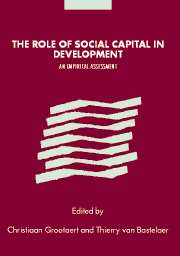Book contents
- Frontmatter
- Contents
- List of figures and maps
- List of tables
- List of boxes
- Notes on contributors
- Acknowledgments
- Foreword by Robert D. Putnam
- Introduction and overview
- Part 1 Social capital at the micro and macro levels: a conceptual discussion and review
- Part 2 The impact of social capital on development
- Part 3 The creation and transformation of social capital
- 7 The impact of development assistance on social capital: evidence from Kenya
- 8 Induced social capital and federations of the rural poor in the Andes
- 9 Social capital and social cohesion: case studies from Cambodia and Rwanda
- 10 Ethnicity, capital formation, and conflict: evidence from Africa
- Conclusion: measuring impact and drawing policy implications
- Index
- References
8 - Induced social capital and federations of the rural poor in the Andes
Published online by Cambridge University Press: 22 September 2009
- Frontmatter
- Contents
- List of figures and maps
- List of tables
- List of boxes
- Notes on contributors
- Acknowledgments
- Foreword by Robert D. Putnam
- Introduction and overview
- Part 1 Social capital at the micro and macro levels: a conceptual discussion and review
- Part 2 The impact of social capital on development
- Part 3 The creation and transformation of social capital
- 7 The impact of development assistance on social capital: evidence from Kenya
- 8 Induced social capital and federations of the rural poor in the Andes
- 9 Social capital and social cohesion: case studies from Cambodia and Rwanda
- 10 Ethnicity, capital formation, and conflict: evidence from Africa
- Conclusion: measuring impact and drawing policy implications
- Index
- References
Summary
Poor people's organizations in the Andes embody an important form of structural social capital. As such they constitute a potentially important asset in people's livelihood strategies and may therefore have important roles to play in poverty reduction strategies. However, such organizations vary widely in scale, role, effectiveness, and degree of inclusiveness and exclusiveness. This diversity means that we must be careful before invoking simple conceptions of “social capital in the Andes” and before making generic (and perhaps romantic) assertions about organizations of the rural poor.
Given the diversity of interests of the rural poor, federated forms of organizations that are able to bridge some of these differences are of particular interest. This chapter reports on a study comparing such organizations in the Andes of Bolivia, Ecuador, and Peru. It presents findings on the different dimensions of social capital embodied in these organizations, the impacts that this social capital may have on local development, and the forms of external intervention through which it might be built.
The importance of organizations of the poor
National governments and multilateral organizations have only recently begun to recognize what nongovernmental organizations (NGOs) have long accepted as an article of faith — that organizations of the poor may have an important role to play in development and that empowerment is an important poverty reduction goal in its own right.
- Type
- Chapter
- Information
- The Role of Social Capital in DevelopmentAn Empirical Assessment, pp. 234 - 278Publisher: Cambridge University PressPrint publication year: 2002
References
- 7
- Cited by

